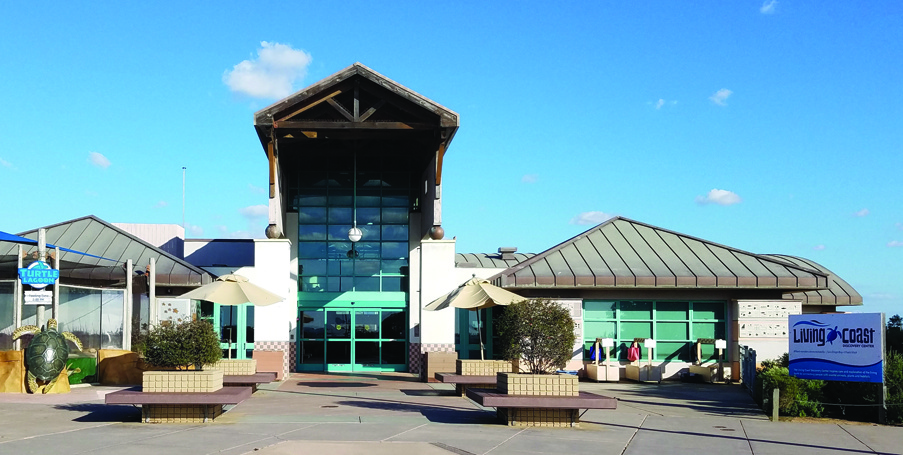In 1987, the Living Coast Discovery Center opened its doors to the public, then under the name Chula Vista Nature Center. Since that time, it has become a core conservation center in South Bay with its conservation, educational, interactive activities, spring and summer camps and more. Located in the San Diego National Wildlife Refuge in Chula Vista, its purpose has always been clear. To save endangered species, educate children and adults on local conservation and the animals that depend on it through its exhibits and all of its programs. The Discovery Center just announced that it will remain closed with a tentative date of reopening May 3, depending on local and federal guidelines at that time due to the COVID-19 pandemic.
Rachel Harper, Living Coast Discovery Center Marketing and Communications manager said that animal care and facility staff is still ongoing onsite to ensure the healthcare and training of the animals, and that the care of the animals and the health of the staff is its top priority. The only difference now, is that there are no people visiting the site.
“We have minimal staff onsite and the staff that is onsite are maintaining social distancing, washing their hands and following all of the health guidelines,” said Harper. “What we are trying to do now is staying very active on social media to connect with the people that are our fans and are interested in what we are doing with our animals and are they okay. We are encouraging people to follow us because we are sharing those stories every day.”
Harper said they have had to cancel events, school field trips, and have postponed some like its spring programs that they are hoping to bring back in the summer.
“We are still planning on doing our summer camps and we are looking for avenues to bring some of our programming online so people can still be able to engage with us. This is something we are still working on and will be updating on our social media,” said Harper.
In regard to working with its conservation partners, the Discovery Center is still working on its conservation projects. Its Light-footed Ridgway’s Rail program is a breed and release program in conjunction with SeaWorld, San Diego Zoo’s Safari Park, U.S. Fish and Wildlife and California Fish and Wildlife.
“That is a program we’ve been involved in for many years now and it is very seasonal,” said Harper. “We breed the chicks at The Center and then raise them, then they go into a proving area before they get released. We are in the middle of this project now. We have breeding pairs of rails at Living Coast and we just welcomed two chicks.”
The light-footed Ridgway’s rail is a hen-sized marsh bird that is long-legged, long-toed, and approximately 14 inches long. It has a slightly down-curved beak and a short, upturned tail. Males and females are identical in plumage. The light-footed Ridgway’s rail uses southern California coastal salt marshes, lagoons, and their maritime environments. The birds nest in the lower littoral zone of coastal salt marshes where dense stands of cordgrass are present. They require shallow water and mudflats for foraging, with adjacent higher vegetation for cover during high water.
Another conservation project is the burrowing owl, an introduction program in partnership with San Diego Zoo Global.
“We have a pair of breeding burrowing owls, or we hope that they’ll be breeding, and they are on exhibit. We are still moving forward with these projects as normal,” said Harper.
Harper said that they many people asking how to help and that The Center understands that this is a challenging time for many people.
“We are asking if anyone does have the means, of course we are accepting donations,” said Harper. “We are non-profit, and we rely on a lot of different types of funding, but a big part of that is our general admissions, school programs revenue.”
Harper said that when you visit the Living Coast, you are directly supporting the animals, facility and exhibition programs, but with The Center closed to the public, it is challenging to find ways to recoup the monetary gains it receives from normal daily operations.
“Without these revenue sources we are accepting tax deductible donations, you can purchase or renew a membership for one year for full admission, and even if you do it now, the membership date will start on the day that we reopen,” said Harper. “We are encouraging people that know that they will be coming to see us, to purchase a membership now, receive additional benefits and you can purchase them as gifts for family members and friends.”
Living Coast also has an Amazon animal wish list for people that want to purchase specifically for items that help support the animals. People can go on its wish list and purchase food and supplies and have them delivered directly to the facility. To keep the community involved, Harper encourages everyone to follow them on social media.
Donations and memberships: thelivingcoast.org
Facebook.com/thelivingcoast
Twitter: @thelivingcoast
Instagram.com/thelivingcoast
Amazon Wish List: amzn.to/wishlistLCDC















